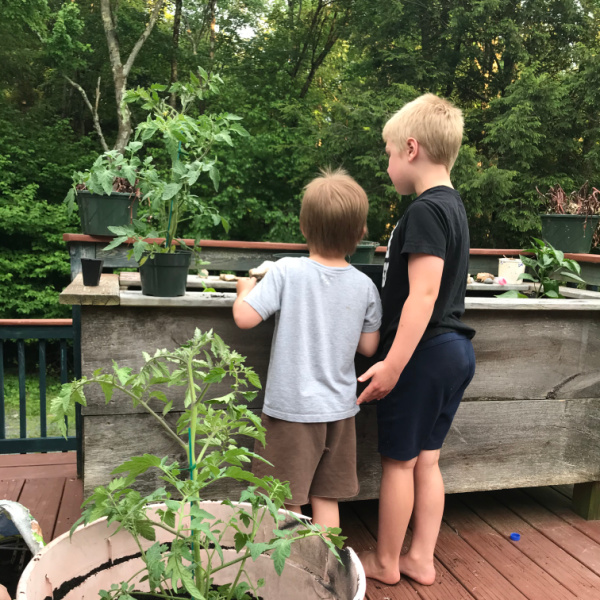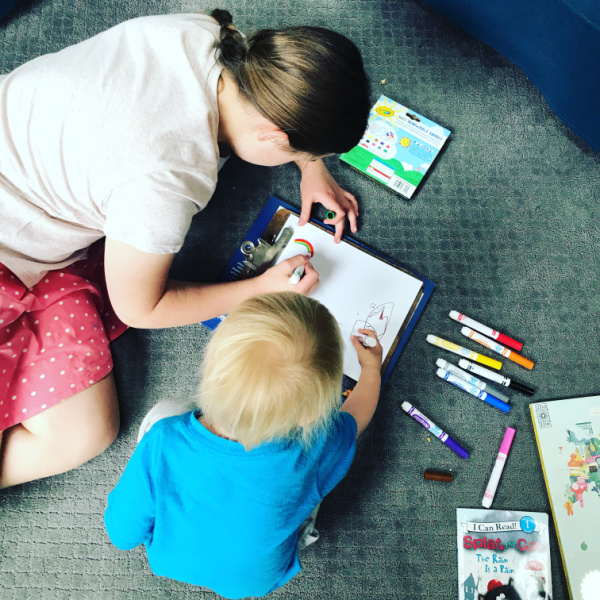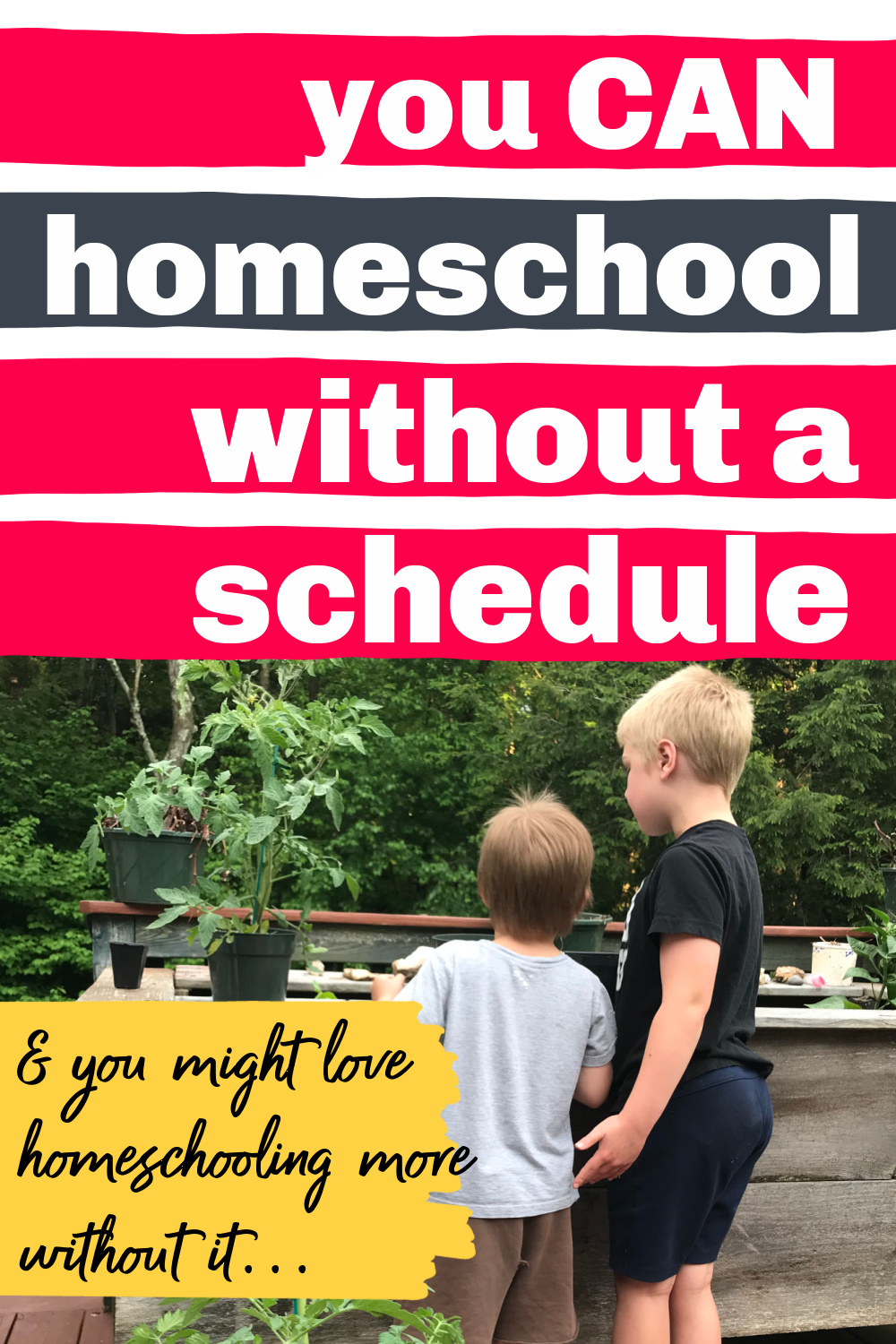Inside: You absolutely can homeschool without the strict, color-coded schedules that too often mimic school. In fact, sometimes ditching the schedule is the only way to make homeschooling work for your family. Get 7 tips on how to homeschool without a schedule without losing your mind, and find reassurance that your kids really will be o.k. without one.
Schedules are a very, very LOUD part of our modern society. Hour time blocks dominate our planners, our workplaces and our schools…and for good reason.
It would be extremely difficult to manage dozens of people and systems efficiently without that level of structure and detail. You probably couldn’t accomplish what’s been set out for you to accomplish – whether that be for a boss or for a school board – without schedules.
It’s no wonder that so.many.parents come to homeschooling with the idea that you need a strict homeschool schedule for your family to thrive.
Everywhere they look, they see a world dominated by schedules – it’s only natural that they would try to pull that scheduled world into their homeschools.
Thank goodness for homeschooling.
Where you don’t need to manage dozens of people, just a few (or five, in my case).
Where you can feel free to say ” heck no” to the “normal”, mainstream and status quo.
But how exactly do you do this homeschooling without a schedule? How do you extricate yourself from what so much of the world considers essential?
I’m going to walk you through the whole subject. We’ll discuss everything from:
- homeschooling schedules versus homeschool routines
- whether or not homeschooling without a schedule is bad for kids
- helping your child create their own schedule if they so desire, and
- specific tips on how to homeschool without a schedule sanely.
Let’s jump in!
Related: How to Create an Unschooling Schedule (No, It’s Not Taboo)

Homeschool Schedules v. Homeschool Routines
THIS POST PROBABLY CONTAINS AFFILIATE LINKS. AS AN AMAZON ASSOCIATE, I EARN FROM QUALIFYING PURCHASES. YOU CAN READ OUR FULL DISCLOSURE POLICY HERE.
Wherever there is talk of homeschool schedules, there are always the homeschool parents who speak up and say something to the effect of, “We don’t use a schedule, but we do have a routine.”
So what is the subtle difference between a homeschool schedule and a homeschool routine?
The essential difference is that routines involve doing the same things every day in a set order without being bound by time. Schedules, on the other hand, are bound by set times. And when the clock hits that next hour, you must move on to the next scheduled activity, regardless of whether or not you’re “finished”.
Schedules are strict bosses, constantly telling you what to do (not the other way around), where routines tend to be more like gentle guides.
For example, maybe you decide to always start the day with a read aloud over breakfast. Next you all clean up the kitchen and immediately move on to math. After that, you have a break until lunch. Immediately after lunch, you work on writing, which is followed by everyone splitting up for the rest of the day to pursue their own individual studies or interests.
This is a routine.
It doesn’t matter if it takes 45 minutes to read one day instead of the usual 30 because you get into a rousing discussion about what it would be like to get shipwrecked on an island. Clean-up and math always come next, regardless of the time on the clock.
So theoretically you could establish a homeschool routine, doing things in the exact same order every day, allowing for flexible time slots for each.
Or like Sara from Happiness is Here, you might also consider creating rhythms, instead:
“A rhythm is basically the flow of your day (or week, or month). If you haven’t intentionally created one already, you likely still have one. You probably eat at similar times each day, have a little morning and night routine, maybe you have weekly commitments.”
Sara, Happiness is Here Blog
We used to have a more regular homeschool routine.
Then I had a fifth child, and after that, my oldest became a pre-teen with even more night owl tendencies. The sleep schedules between my five children vary so wildly that one child wakes up around 7:30 and another around 10:30 or 11 a.m.
And more recently, the toddler dropped a nap, throwing off our rhythms and routines yet again.
The routine stopped being helpful and supportive. It started to feel more like a schedule, bossing me around, making me feel like we were never doing enough. So for the moment, I’ve given up on homeschooling with a schedule OR a routine.
We have a few core things we do each day, and we fit them in and around my work and the toddler’s waking hours. Other than that, we do a lot of learning through play and the kids exploring their own interests with my support.
We have a few basic family rhythms like nightly kitchen clean-up and individual reading before bed, weekend family nature walks and waffle breakfast every Sunday morning.
But no schedule or regular routines, at least not arbitrary, adult-created ones (see more below).
Maybe one day we will return to a schedule, but for now, I’ve fully embraced homeschooling without a schedule. It works really well with our family’s current dynamics.
Related: The Top 12 Unschooling Books for Rethinking Education

Is Homeschooling Without a Schedule Bad for Kids?
Woah, woah, woah. But don’t kids need a schedule to thrive?
A common argument for keeping a relatively strict schedule – in school or in a homeschool – is that kids not only like, but need structure.
The argument goes that they need to do the same things every day in the same order, that it gives them a sense of security and safety. Others argue that if they have more freedom and control, they will be incapable of holding a job later in life.
And I’m not saying you need to completely ditch structure, just to let go of arbitrary, adult-created structure.
In her article “The Myth of Structure”, Sue Patterson puts it this way:
“Life brings structure – winding down for bedtimes, making it on time and prepared for soccer practice twice a week, showing up for park days with blankets, chairs, snacks and water bottles, getting to the post office before it closes…Structure is all around us. We don’t need to create arbitrary structure.”
Sue Patterson, Unschooling Mom2Mom
And not everyone thrives on hour blocks, schedules and routines.
In fact, some adults specifically seek out work that offers new and exciting experiences every single day. Predictability and routines quite literally stifle them.
Those who thrive on routines and predictabilty tend to be “J’s” on the Myer’s Briggs personality scale, while those who love spontaneity and prefer not have a lot of set plans tend to be “P’s” on the Myer’s Briggs scale (source).
Not all children are J’s. Not all adults are J’s.
While yes, many children do need basic routines, that can be easily satisfied with natural routines like a simple morning routine, a bedtime routine, activities you do on a regular basis. Their entire day doesn’t need to be micromanaged for them to thrive.
“It is generally believed that children require adult control and micromanagement, and without it there would be dire consequences. Control is justified as for children’s own good. But control is not the solution – it is the problem.”
Sara, Happiness Is Here
My hunch is that the “kids need routine” assertion comes from a worldview and perspective that assumes adults need to control everything. And to put it simply: they don’t.
You don’t need to go with the mainstream way of doing pretty much anything. If homeschooling without a schedule works for you and your family, go for it.
Interesting Thought: I recently listened to THIS podcast which described the difference between a maker’s schedule and a manager’s schedule.
My husband and I both have jobs that are far more “maker” than “manager”, which is possibly why we both resist perfectly hour blocked schedules in general and tend to prefer open-ended stretches of work that aren’t bound by specific times, interruptions or “bells” declaring work is over and it’s time to move on.
Perhaps this is why I’m drawn to homeschooling without a time-blocked, bossy schedule? Are you more of a maker or a manager in your line of work? Perhaps it affects how you homeschool?

But What If My Child Asks for a Schedule?
While not all kids need schedules to thrive, you may have a child who seems to be struggling with the lack of a set schedule or routine beyond morning/nighttime routines.
You can usually tell from behavior with younger children, and older children will usually express it themselves if they are raised to prioritize self-awareness.
One of my children, for example, went through a phase last year where she wanted a schedule, so I helped her make one. She wrote down in order the list of activities she wanted to get done.
She didn’t tie set times to those things once she realized how the amount of time it took to do each activity varied constantly. Her list satisfied her need for order and routine, while not interfering with the rest of our more laid back homeschool lifestyle.
(Interesting Side Note: She later abandoned the daily rigid, schedule-bound to-do list because she realized it constantly made her feel like a failure if she didn’t cross something off her list.)
If you find that your child is craving more order/routine/structure, absolutely support that child in creating a schedule/routine that meshes with the rest of your homeschool day.
This may be a phase that peters out after a while, or it could be a long-term sign that this particular child truly does need – and thrive – with a more set schedule.
Related: 20+ Brilliant Homeschooling Tips for Beginners

How to Homeschool Without a Schedule – 7 Tips
Here are my best tips for homeschooling without a schedule without going crazy or thinking you’re failing all the time.
1. Clarify why you want (or need) to homeschool without a schedule.
When you want to homeschool without a schedule, you’re definitely not following the crowd. Everywhere I look, there are “sample homeschool schedules”, each hour time block carefully filled – no gaps, no time unscheduled.
Depending on how much of a people pleaser you are, seeing those schedules can make you feel insecure, at best. Ignoring the siren call to craft a picture perfect homeschool schedule can be difficult…or make you feel like a big homeschool mom failure.
So you need to remind yourself why schedules don’t work for you, whether that’s just for a season or you’re an anti-scheduler for life (props if that’s you).
There are so many great reasons to homeschool without a schedule…
Maybe you have a constantly growing family with little ones and their ever-evolving stages being added to the mix every other year (or more often!). Their needs make keeping a strict homeschool schedule impossible.
Maybe you are a foster parent, in addition to homeschooling your own kids. You are constantly juggling appointments, and there are too many unknowns to count.
You couldn’t possibly stick to a schedule because it would get broken more often than not when something unexpected comes up. It always does.
Maybe your kids are on different circadian rhythms. When no one gets up at the same time, sticking to a homeschool schedule can be challenging.
Maybe schedules feel way too much like school to you. You hate the idea of needing to wrap up history right at 10am just because the schedule says so.
What if you’re really into a deep discussion about the Civil War? You’re just going to stop and move on to science because you’re a slave to almighty homeschool schedule?
Maybe you’re a free spirit who adores spontaneity and hates schedules like no other. You don’t want to be held down to a schedule because who knows? You could wake up to beautiful weather that calls your family to the lake or a nature walk.
You love leaving room for new learning experiences and amazing life experiences – it’s why you homeschool, after all. If you wanted a schedule, you would send your kids to school.
All of these things are great reasons. Write down yours to remind yourself when you see those fancy homeschool schedules on Pinterest or Facebook.
Related: Why Homeschool – Four Compelling Secular Reasons to Try It
2. Homeschool without curriculum, or ditch the curriculum’s suggested schedule/pace.
I owe my start in homeschooling to a boxed curriculum. That being said, I left it behind after year one and never looked back.
One of the things that drove me crazy about using curriculum was the schedule. Every day was mapped out, with lots of boxes to check.
And if you didn’t get all the things done on one day, you were suddenly behind. And once you get behind, you’re constantly playing catch-up.
Playing catch-up is no fun. No fun at all. It can make you a huge stress ball for no good reason other than “the schedule says so”.
For me, all it took was one schedule slip up to start the catch-up cycle. Maybe I’m too much of a perfectionist. Maybe another mom would be able to easily let it go, add it to tomorrow’s schedule, or let that chapter go altogether.
I never managed to do it.
I function much better as a homeschool mom when I don’t aim to finish our books or materials or hit specific, concrete goals by the end of a school year.
We simply do the next thing the next day. We read one more half-chapter of history, two more chapters in our read-aloud, play one more board game.
If something comes up one day, and we need skip our routine activities, I no longer stress out about it. We simply pick back up tomorrow where we left off.
Related: 14 Easy Ways to Homeschool Geography without Curriculum
3. Know your daily homeschool priorities, and order them from most to least important.
If you’ve never sat down to prioritize homeschool activities or subjects, now is the time.
How can you possibly know what to let go of and what you absolutely must get to – because it matters to you, not because school’s say so – without prioritizing?
Sit down right now and put your homeschool subjects or activities in order, from most important to least important.
To help you get started, I’ll share my own current homeschool priorities:
- Read-aloud from our latest chapter book.
- Do reading lessons with anyone who is currently learning to read.
- Support my kids with their individual interests and activities.
- Read history with my child who adores it (I love history!).
- Play a few educational board games a week.
My number one priority is reading aloud, and it happens 99/100 days. It’s really rare for us to go a weekday without our reading aloud. If I have a child currently learning to read, working on reading one-on-one takes the next top priority slot.
After that, everything else is gravy.
Especially in my current season of homeschooling with toddlers, prioritizing is an absolute must.
They are demanding little ones, toddlers, and when there is a toddler in the house, I spend a LOT of my days emotionally and physically tending to their needs. Homeschooling needs to be fit in around the toddler, not the other way around.
When all I have is an hour long nap, I know that reading aloud is taking that slot. If there’s time for more, there’s time for more. If not, it’ll have to do.
4. Encourage and empower your kids to follow their own interests independently.
As you might have already guessed, we are relaxed homeschoolers/borderline unschoolers. The majority of our homeschool days are spent following our individual interests.
To be honest, this is what makes homeschooling without a schedule work for us.
I can’t imagine trying to fit in all the things I see some homeschool families doing every day without an extremely strict schedule. You just couldn’t do it any other way.
The only other way you could probably make it work is if your kids do a lot of adult-given, curriculum or workbook-oriented, independent work.
But I would encourage you to trust and empower your children. If you don’t stifle it with information they aren’t interested in, their curiosity really will drive them to want to learn naturally. They are learning all the time – they can’t not learn.
Their learning might not look like much to adults, like my 9-year-old son who, at the moment spends much of his time learning and practicing magic tricks. He spends hours watching YouTube videos in order to master a particular trick.
What is he possibly learning that’s valuable?
He’s learning and practicing the most important thing of all: how to find the information he needs to satisfy his own curiosity and develop a level of mastery that satisfies his own goals and aims.
5. Keep your educational objectives broad and open-ended.
When you homeschool without a schedule, you need to adjust your expectations. When you let go of schedules, you need to let go of strict objectives, too.
Instead of setting objectives that aim to complete specific books or workbooks or activities, keep your objectives broad and open-ended.
For example, my objective for writing is, “students will gain more experience with various kinds of writing, by hand and/or using a computer” (source).
Objectives like this one leave tons of room for interest-led learning and practicing writing as it comes up in every day life, which it inevitably does, along with any other intentional writing exercises I choose to include in our homeschool year.
When you leave your objectives and educational aims open-ended and flexible, it takes the pressure off and gives you more freedom to ditch whatever plans you’ve made when you need to. That could be because an awesome learning opportunity presents itself randomly or because an unexpected emergency arises.
Any seasoned homeschool mom knows that life happens, more often than we care to admit.
In case you’re new, what does “life happens” mean?
It means that the house doesn’t care that you need to homeschool five kids when a pipe in your laundry room decides to break (#truestory). The stomach bug going through seven people doesn’t care that you were supposed to read such and such chapter today – heck no, everyone’s puking, and that reading is NOT going to happen, not today.
In my experience, homeschool schedules rarely make room for life happening, so keeping those objectives broad and non-specific makes it easier to homeschool without a schedule.
6. Know the best time(s) of day to get things done, and make sure everyone else knows those times, too.
Think through what your best times of day are, the ones where everyone is generally agreeable and ready to do group homeschool activities.
Around here, any time the toddler is sleeping, we seize that time. That’s when we read, play board games, and do pretty much anything else that can be destroyed or interrupted by a toddler.
Homeschool activities get that slot more often than not, taking precedence even over my work, which I fit into the margins of the toddler’s waking hours.
The key is to make sure everyone in our family knows that we are waiting for those times, so they expect that as soon as the toddler naps or goes down to sleep for the night, it’s time to read or play a board game or do anything else that requires concentrated time, attention or support.
Maybe your best time is the morning.
So you make sure everyone knows that when the last child gets up and eats breakfast, you’re going to do some part of your homeschool activities at that time, whatever time that happens to be on any given day. Everyone gets some kind of warning (10-15 minutes) to finish what they’re doing and get ready to work or read or be together.
Communication is key to make homeschooling without a schedule work for everyone.
7. When you feel the urge to create a strict schedule, go for it – but for yourself, not the kids.
For adults, the lack of a strict schedule can feel scary. It’s letting go of control and trusting our kids to follow their instincts, to know when they want to play/learn and when they need to rest.
Looking back, all of the times I’ve had the sudden urge to create a stricter homeschool schedule, it’s always come from fear.
Fear that I’m not doing enough.
Fear that they’re not learning enough.
Fear that I’m “ruining them” without strict schedules or rigid routines, as many mainstream parenting “experts” like to suggest on the daily (I’m lookin’ at you, Facebook shares).
Fear is never a good reason to create a strict homeschool schedule, and every homeschool decision I’ve made out of fear has backfired, and I’ve seriously regretted it.
So what do I do now when I feel that fear and want to “crack down”? I implement more structure for myself because the only person I can (or should, in my opinion) really control is myself.
I can give timely, gentle advice and basic guidelines for healthy and safety, stay connected to my kids’ hearts and model the life and behavior I want them to live. But at the end of the day, they need to learn self-control, not how to be controlled, how to know what they need and get those needs met.
When I’m afraid, I focus that energy on improving my own self-control and my own habits and routines, knowing that my kids are always watching me. “More is caught than taught,” so the saying goes. And when I do that, I feel better, I’m a happier and healthier homeschool mom, which is what my kids really need, not stricter schedules.
Related: What Is Respectful Parenting? A Refreshingly Radical Philosophy

When I Found the Courage to Ditch the Schedules, I Finally Fell in Love With Homeschooling
When we first started homeschooling, I was extremely insecure. I thought I was going to mess up this whole homeschooling thing.
Schedules made me feel a little bit better in the beginning, more in control.
But eventually, they started to suck the life out of homeschooling for me and for my kids. I thought a lot about that big yellow school bus and what my life would look like if I sent my kids to school.
The schedules ultimately made me feel like I was failing.
Only after I started to let go of the schedules, to embrace a lifestyle of learning did I start to fall in love with homeschooling.
Now instead of dreams of school I can’t imagine giving up the freedom we have – the freedom to live life on our terms, to every day follow our interests and intuition and learn SO much in the process.
Maybe homeschooling without a schedule will give you the same gift, or maybe it’s just what you need to keep homeschooling during a difficult season.
Either way, I hope this article gives you the reassurance and tools you need to homeschool without a schedule for however long it serves you. You’ve got this!
Read Next: Our Big Family Homeschool Schedule That’s A Little Unconventional



Thank you for this eye opening article. I knew something was off with our homeschool routine when, only a month in, we were “behind” and had more tears and frustrations about meeting deadlines than progress. You helped me realize it’s my ingrained belief that we need to have a rigid schedule to be successful and that homeschooling is about freedom & focusing on my kids specific needs, not schooling the old way at home. Again, THANK YOU!!!!
You’re so welcome!